How Biden could transform global green bonds
by Johann Plé*
In July, US President-elect Joe Biden announced plans to spend US$2 trillion (A$2.74 trillion) to progress the use of clean energy in areas including transportation, electricity generation and construction over the next four years. As part of a group of proposals designed to tackle the growing threat of climate change across the US, this was the first such major commitment from a US leader – be that a nominee or a president.
We know it will now be challenging for President Biden to implement such plans with a potentially divided congress but we believe these plans – even though they might be less ambitious – alongside his pledge to sign the US back up to the Paris Agreement on the first day of his presidency, could have an important effect on the green bond market. Over the long term, this act could lead to a broader rebalancing between the US market and its Euro counterpart.
Moreover, we (AXA Investment Managers) believe it could represent the final step in cementing the global green bond market as a credible alternative to that of traditional global bonds.
The proposed deployment of Biden’s investment pledge could very likely be funded in part by Green bonds. We have seen this through the EU Recovery Fund, a €750 billion (A$1.218 trillion) recovery effort to help the EU tackle the crisis caused by the COVID-19 pandemic, 30 per cent of which is due to be issued via green bonds.
US lags in green bond issuance
Currently, green bond issuances in US dollars only represent 23 per cent of the green bond market compared to nearly 33 per cent at the end of 2017. With US$70 billion in capitalisation, the investment grade (IG) green bonds issued in dollars remain a very small part of the US IG credit market.
Whereas the green bonds issued in Euros have grown exponentially to weigh more than US$140 billion and represent 5 per cent of the European IG credit market today. So, why has the US market lagged so far behind its European counterpart?
The first factor is that the US has never been a driving force on climate change issues, giving little credit to the subject but also to its potential economic consequences.
This has contributed to a certain disinterest in green bonds across the Channel, both from issuers and investors. When combined with the additional costs associated with issuing a green bond (due to factors such as the creation of an issuance framework, a project selection committee or the production of additional reporting, for example), it is perhaps unsurprising that we have so far seen so few US names coming to the market. However, a change has begun to take place.
High profile climate change disasters have become more and more frequent and beyond their human impact, their economic impact can no longer be ignored. According to the latest United Nations report, their number has doubled in the past 20 years and their cost is estimated at US$3 trillion. We therefore observe a shift in the discourse of politicians, reflecting a collective and global awareness.
Thus, the consideration of extra-financial criteria and environmental issues are emerging beyond the European continent among American investors. At the same time, the need to integrate the risk associated with climate change is therefore leading American companies to review their strategies and take an interest in the green bond markets in this context.
This surge has recently seen some high-profile US companies take an interest. We suspect it won’t be long until we see more names, offering a chance to not just show their commitment to a greener transition, but also as a way to capture investor interest both at home and further afield.
US green bond issuance to grow
Amidst this backdrop, the US market is trying to keep pace with the issuance of green bonds in Europe but is struggling to keep pace, continuing to strengthen the predominance of Euro issues in the universe.
However, where the Trump administration favoured investment in fossil fuels, we believe that Biden’s presidential win could turn the tide.
Indeed, the US IG credit market alone is nearly 2.5 times larger than its European counterpart, and therefore represents colossal growth potential.
As natural disasters become more violent and frequent, every business and state must adapt and invest. We can therefore expect that the growth momentum of the US green bond market will continue to intensify.
*Johann Plé is the green bonds strategy manager for global fund manager AXA IM.









